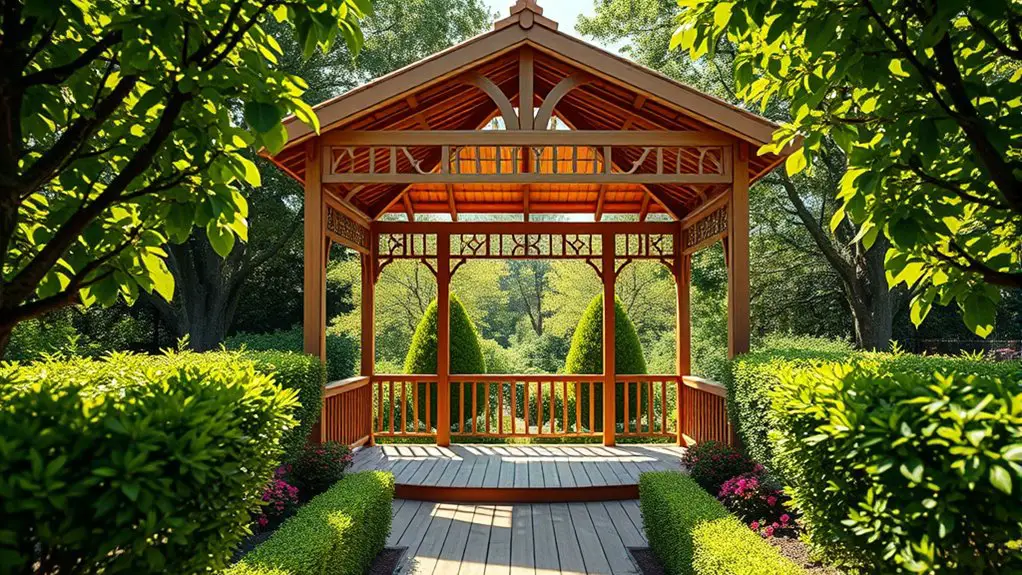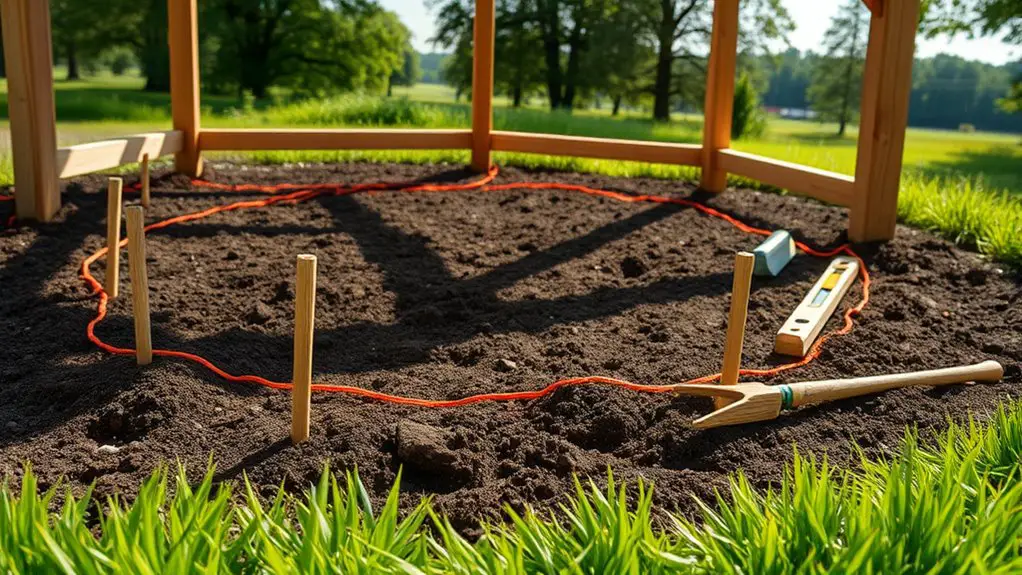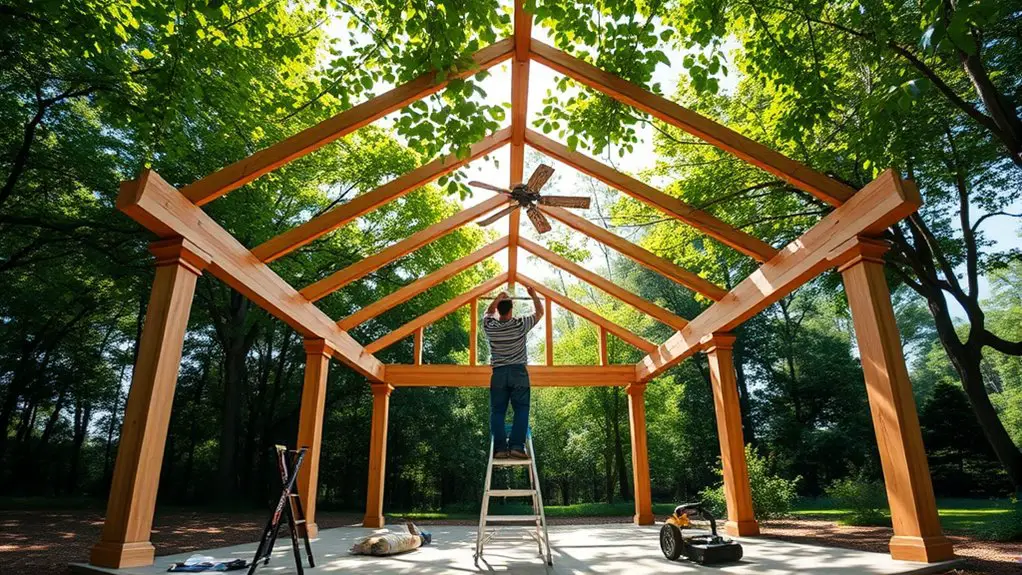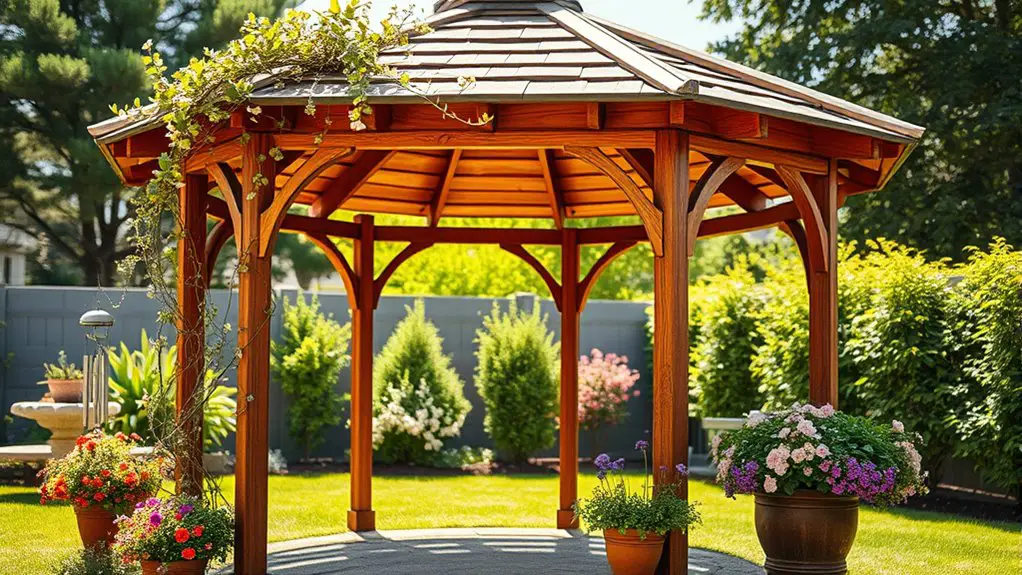To build a free-standing gazebo without walls, start by planning your design to fit your space and style. Choose a sunny location with stable ground and easy access. Gather durable materials like pressure-treated lumber and essential tools like a saw and drill. Prepare a level foundation, then construct a sturdy frame with vertical posts and horizontal beams. Add a roof with proper drainage, and enhance your space with flooring, decor, and furniture for comfort. There’s so much more to explore!
Planning Your Gazebo Design

When planning your gazebo design, start by considering three key elements: size, style, and location. The size of your gazebo should align with both your available space and intended use, whether it’s for hosting gatherings or a tranquil retreat. Next, think about the style; do you envision a rustic wooden structure or a sleek modern design? Your choice will greatly influence the design aesthetics, creating an inviting atmosphere that resonates with your personal taste. Finally, incorporate functional features that enhance usability, like built-in seating or lighting options. These elements not only elevate the gazebo’s charm but also guarantee it serves its purpose effectively. A well-designed gazebo will enhance curb appeal and attract buyers, balancing aesthetics with functionality will lead you to a design that embodies freedom—an open, airy space that invites you to relax and enjoy your surroundings. With these considerations in mind, your gazebo will become a cherished extension of your outdoor lifestyle.
Choosing the Right Location
When choosing the right location for your gazebo, you’ll want to take into account the balance between sunlight and shade to guarantee comfort throughout the day. Additionally, evaluating the ground’s stability is essential to prevent structural issues down the line. Don’t forget about accessibility and visibility; a well-placed gazebo enhances your outdoor experience and invites social gatherings. Consider the surrounding landscape to ensure that your gazebo complements the natural beauty of your yard.
Sunlight and Shade Balance
Although selecting the right location for your free-standing gazebo may seem straightforward, it’s essential to take into account the balance between sunlight and shade to maximize comfort and usability. Start by observing the sunlight angles throughout the day. This’ll help you determine how the sun moves across your yard, allowing you to position your gazebo strategically. Consider shade types, like the natural cover from trees or artificial options like canopies. A well-placed gazebo can offer a retreat from harsh midday sun while still capturing the gentle warmth of early morning or late afternoon rays. Ultimately, finding this equilibrium will enhance your outdoor experience, giving you the freedom to enjoy your space in comfort, regardless of the time of day.
Ground Stability Assessment
Before you start building your free-standing gazebo, evaluating the ground stability of your chosen location is essential. Conduct soil testing to assess the soil type and its load capacity. Sandy soils drain well but may not support heavy structures, while clay soils are more stable but can retain water, leading to erosion. Use a soil probe or auger to check the depth and consistency of the soil. If the ground is too loose, consider reinforcing the area with gravel or compacted soil to enhance stability. A solid foundation is vital for your gazebo’s longevity and safety, allowing you to enjoy your outdoor haven without worry. Choose wisely, and your gazebo will stand strong against nature’s elements.
Accessibility and Visibility
After ensuring your ground is stable, the next step is to contemplate accessibility and visibility when selecting the right location for your gazebo. You’ll want to choose a spot that’s easy to access, allowing guests to flow freely in and out. An open design enhances this experience, blending seamlessly with your landscape. Consider nearby pathways or existing structures that might obstruct views; you want your gazebo to be a focal point, exuding visual appeal. Place it where it can be admired, perhaps near a garden or water feature, creating an inviting atmosphere. Additionally, think about sunlight and shade—position your gazebo to balance comfort and aesthetics, ensuring it becomes a cherished retreat in your outdoor haven.
Gathering Materials and Tools
To successfully build a free-standing gazebo, you’ll need to gather a specific set of materials and tools that will guarantee your project runs smoothly. Start by selecting sturdy material types like pressure-treated lumber or cedar for durability against the elements. You’ll want to choose a mix of 2x4s for the frame and larger beams for the roof.
Next, your tool selection is essential. A circular saw will help you make precise cuts, while a level guarantees everything is perfectly aligned. Don’t forget a drill for fasteners and a tape measure for accuracy. For a polished finish, consider sandpaper and wood stain.
Additionally, choosing the right material options for your gazebo can significantly impact its longevity and aesthetic appeal.
With these materials and tools in hand, you’re well-equipped to create a gazebo that embodies your desire for freedom and relaxation, allowing you to enjoy the great outdoors in style. Happy building!
Preparing the Foundation

Before you start building your gazebo, it’s essential to select the right location that offers both aesthetic appeal and stability. Make sure the ground surface is level, as uneven terrain can lead to structural issues down the line. By taking these initial steps seriously, you’ll set a solid foundation for your project. Additionally, it’s crucial to check for underground utilities before digging to avoid any potential hazards.
Choosing the Right Location
Selecting the perfect spot for your free-standing gazebo is essential, as it sets the foundation for both aesthetics and functionality. Consider your site selection carefully, taking into account environmental considerations like sunlight, wind, and drainage. A well-chosen location will enhance your experience and blend seamlessly into the landscape.
| Factor | Importance | Tips |
|---|---|---|
| Sunlight | Crucial for warmth | Position for morning sun |
| Wind Exposure | Comfort and stability | Shield from strong winds |
| Drainage | Prevents flooding | Elevate on a slight slope |
| Surrounding Landscape | Visual appeal | Integrate with natural features |
Leveling the Ground Surface
As you prepare to build your free-standing gazebo, leveling the ground surface is an essential step that can’t be overlooked. Begin by evaluating your soil type—sandy, clay, or loamy—as it affects drainage solutions. If your soil retains water, you’ll need to create a slight slope for efficient runoff, preventing pooling. Use stakes and a string level to mark your desired height, then dig or fill as necessary to achieve a flat surface. For added stability, consider compacting the ground or laying gravel as a base. Proper leveling not only guarantees your gazebo stands strong but also enhances its aesthetic appeal, allowing you to fully enjoy the freedom of your outdoor space.
Constructing the Frame
To begin constructing the frame of your free-standing gazebo, you’ll want to gather your materials and tools for a smooth process. Essential frame materials include treated lumber, metal brackets, and screws for durability. Start by laying out the base, ensuring each corner is square, and secure it with proper structural support to maintain stability. Additionally, ensure that the site is level before beginning construction to provide a solid foundation.
Here’s a quick reference table for your frame materials:
| Material | Purpose |
|---|---|
| Treated Lumber | Main frame components |
| Metal Brackets | Joint reinforcement |
| Screws | Securing connections |
| Concrete Mix | Anchoring the base |
Once you’ve established the foundation, erect vertical posts at each corner. Connect these with horizontal beams to create a sturdy frame that’ll withstand the elements. Remember, your gazebo should not only be functional but also a free space to enjoy the outdoors.
Adding the Roof

Now that your frame is securely in place, it’s time to crown your gazebo with a roof that not only enhances its aesthetic appeal but also provides protection from the elements. When choosing roof materials, consider options like shingles, metal, or thatch, each offering unique benefits and styles. For a rustic look, wooden shingles can blend seamlessly with nature, while metal roofing provides durability and a modern touch. Additionally, you might explore using polycarbonate materials, which are lightweight and UV resistant, for a roof that also offers good insulation.
Next, think about your roof design. A simple gable or a more complex hip roof can dramatically change your gazebo’s silhouette. Verify your design allows for proper drainage; a slight pitch will keep water from pooling. Use sturdy rafters to support your chosen materials, and don’t forget to include overhangs for extra protection from rain. With the right materials and a thoughtful design, you’ll create a roof that not only looks stunning but also stands the test of time.
Installing Flooring
One of the most essential steps in creating your free-standing gazebo is installing the flooring, which sets the foundation for comfort and functionality. Choosing the right flooring materials can elevate your outdoor experience. Here’s how to proceed with effective installation techniques:
Installing the flooring is crucial for your gazebo, ensuring comfort and a strong foundation for outdoor enjoyment.
- Select Your Materials: Consider options like composite decking, pressure-treated wood, or stone pavers that resonate with your style.
- Prepare the Ground: Clear the area of debris, ensuring a level surface to prevent any settling or shifting.
- Lay the Foundation: Use gravel or concrete footings for stability, especially if you’re using heavier materials.
- Install the Flooring: Secure your chosen material, ensuring proper alignment and spacing for expansion and contraction. Additionally, maintaining regular inspections for damages throughout the gazebo’s lifespan can help identify any potential issues early on.
With the right flooring in place, you’ll create a solid base for your gazebo that invites you to enjoy nature in style and comfort.
Enhancing With Decor and Furniture
With the flooring securely installed, it’s time to bring your gazebo to life through thoughtful decor and furniture choices. Start with furniture selection that complements your lifestyle; consider comfortable, weather-resistant seating options like wicker or aluminum chairs. A small table can be perfect for drinks or snacks, inviting relaxation.
Next, explore various decor themes to enhance the ambiance—rustic charm, modern minimalism, or even tropical flair could transform your space. Use vibrant cushions and throws to add color and comfort, while string lights or lanterns create a cozy atmosphere for evening enjoyment. Additionally, incorporating outdoor lighting options can enhance the overall decor and atmosphere of your gazebo.
Incorporate plants or decorative elements like sculptures to connect your gazebo with nature, enhancing the feeling of freedom. Ultimately, your choices should reflect your personality, creating an inviting retreat where you can unwind and enjoy the beauty around you.
Maintaining Your Gazebo
Maintaining your gazebo is essential for preserving its beauty and longevity. Regular gazebo maintenance not only enhances your outdoor space but also guarantees it stands the test of time. Here are four key steps for seasonal upkeep:
- Clean the Surface: Sweep away debris and wash surfaces with mild soap and water to prevent mold and mildew.
- Inspect for Damage: Check for cracks, loose boards, or rusted hardware that could compromise stability and safety.
- Seal and Protect: Apply a weather-resistant sealant to wooden surfaces, and use rust-resistant paint on metal parts to shield against the elements.
- Trim Surrounding Vegetation: Keep plants and trees trimmed back to minimize debris and potential damage from falling branches. Additionally, follow a maintenance schedule to ensure consistent care and longevity of your gazebo.
Frequently Asked Questions
What Are the Local Regulations for Building a Gazebo?
Before starting, check local regulations regarding building permits and zoning laws. You’ll want to make certain your gazebo complies with these rules, allowing you the freedom to create without running into legal issues later on.
Can I Use Recycled Materials for My Gazebo?
Absolutely, you can use recycled wood for your gazebo! It’s not only eco-friendly but also adds unique character. Explore various eco-friendly options to enhance sustainability while ensuring your structure remains sturdy and visually appealing.
How Long Does It Typically Take to Build a Gazebo?
You might think building a gazebo takes forever, but with proper project planning, a typical construction timeline can be as short as a weekend. You’ve just got to stay organized and focused throughout the process!
What Type of Roof Is Best for a Gazebo?
When choosing a roof for your gazebo, consider a gable roof for its classic, open feel, or a hip roof for enhanced stability and aesthetic appeal. Both options offer unique advantages, enhancing your outdoor experience beautifully.
Are There Any Safety Tips for Using Power Tools?
Using power tools without safety precautions is like sailing without a life jacket. Always wear protective gear, maintain tools regularly, and stay focused. A safe workspace guarantees your freedom to create without worry, enhancing your craftsmanship.

